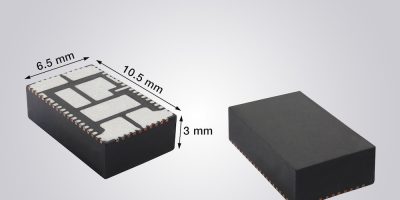PoL converters increase power density in industry’s smallest regulator modules
Offered in 10.6 x 6.5 x 3.0mm packages, microBRICK devices are up to 69 per cent smaller than competing solutions, said Vishay Intertechnology.
The Vishay Siliconix SiC931, SiC951 and SiC967, 6.0, 20 and 25A microBRICK synchronous buck regulator modules are designed to deliver increased power density and efficiency for point of load (POL) converters. They are claimed to be the smallest such devices on the market, with the lowest height, yet feature wide input voltage ranges from 4.5V to 60V.
Each regulator module has two high performance MOSFETs, an inductor, and a controller, with only minimal external components needed for configuration and loop compensation. The compact size dramatically increases power density, said Vishay, while the level of integration is claimed to reduce design complexity and time to market. The regulators’ controllers consume minimum quiescent current, enabling peak efficiencies of up to 97 per cent. In data centres, the telecomms infrastructure, and industrial applications, microBRICK regulators help reduce energy consumption by more efficiently delivering power to FPGAs, ASICs, and SoC core power supplies.
The regulators are configurable and combine wide input voltage ranges with adjustable output voltages down to 0.3V. Of particular note, is the SiC931 which features four programmable switching frequencies at 600kHz, 1MHz, 1.5MHz, and 2MHz. The SiC967 and SiC951 offer adjustable switching ranges from 100kHz to 2MHz and 300kHz to 1.5MHz, respectively. All three devices offer an adjustable current limit but the SiC931 features an adjustable soft start and the PMBus 1.3-compliant SiC951 supports sequential, tracking, and simultaneous operation.
The regulator modules can be used in PoL converters in servers, cloud computing, high performance computing, and desktop computers as well as industrial automation, motor drives, and tools. They are also suitable for surveillance systems, consumer electronics and 5G telecomms equipment. The SiC951 and SiC967 offer three operating modes: forced continuous conduction, ultrasonic, and power save while the SiC931 provides forced continuous conduction and power save modes. In power-saving mode, when the inductor current crosses zero, the control scheme turns off the low side MOSFET to deploy a diode emulation mode. The switching frequency decreases in proportion to load conditions. There is no minimum switching frequency limitation, allowing for the best possible efficiency at light loads.
The devices’ constant on-time architecture delivers fast transient response with minimum output capacitance and tight ripple regulation at very light loads. It also enables loop stability regardless of the type of output capacitor used, including low ESR ceramic capacitors.
The regulators’ have output over-voltage and under-voltage protection, cycle by cycle over current protection, short circuit protection with auto retry, over temperature protection and a power good flag.
Samples and production quantities of the new regulator modules are available now, with lead times of 20 weeks.




